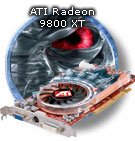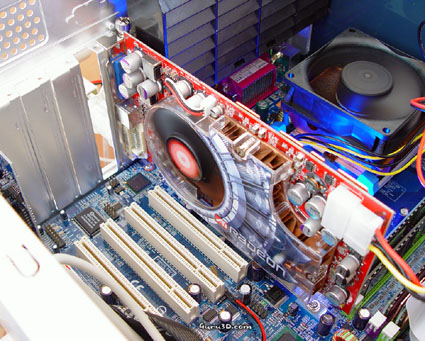 Product type: Graphics card
Product type: Graphics cardManufacturer: ATI
Website: www.ati.comMSRP: 499 USD
Seek best price for products of this type.
 Product type: Graphics card
Product type: Graphics card
Manufacturer: ATI
Website: www.ati.comMSRP: 499 USD
Seek best price for products of this type.
Man, what a hectic 12 months in the graphics industry these have been. A couple of weeks after its release, we received the youngest baby from ATI to review and although submitted a tad late; the product we are going to review today is a true powerhouse in the fierce graphics arena, a product developed under codename R360. Of course I'm talking about the all new Radeon 9800 XT which is targeted directly at NVIDIA's flagship, the GeForce FX 5950 Ultra. There was and still is a lot of hype surrounding this 500 USD product as it was supposed to be bundled with Half-life2. Unfortunately the makes of HL2 (Valve) have had a very nasty experience with a hacker, Half-life 2 leaked and it's extremely quiet at Valve. The downside for ATI here is that they can not bundle the game directly together with the product. No worries, you get a coupon and can download the game when it's available (or pay some shipping fee and it'll be send to you). But oh boy, what a ride that has been and not exactly "the way it was meant to be played" alright.
But back to the hardware that is called Radeon 9800 XT, a highly efficient and programmable graphics card with a computational speed that is simply breath-taking. The product ladies and gentlemen is nothing new in the sense of technology. What you are looking at is a refresh product, faster clocked and better cooled Radeon 9800 Pro with a very nice cooling solution on top of it.
The Radeon 9800 XT has a slightly faster clocked core which is running at a default frequency of 412 MHz, that's not a fixed setting though but we'll get into that later. 412 MHz by itself is amazing for a .15 micron product, ladies and gentlemen. I've been told by several technicians that this process could not go any further than roughly 400 MHz, well, ATI managed that alright. The pro model was clocked at 380 MHz and as you can see that's an 8% increase in frequency. This will be the last high-end .15-micron product from ATI though. They have to move towards .13 or will run into limitations.
With a faster core frequency usually also comes a faster memory frequency, and indeed the XT is now purring at 365 MHz DDR clock frequency. That's 730 MHz effective and a 7% increase over the 9800 Pro, of course still running a 256-bit DDR memory interface.
New on the Radeon 9800 XT is a thermal diode. Although you can't read the temperature of your graphics core, your hardware will monitor it. With a specific reason, in 3D games this product will overclock itself within very safe boundaries to get you a little extra performance. The feature has been labeled 'Overdrive' and was introduced in the Catalyst 3.8 drivers. It's an interesting approach but set a little too safe in my opinion. In our benchmark run you'll see why I said that. I have to make a quick sidenote here, OverDrive is at default disabled.
As stated R360 is the architectural design codename of the product, R350 which you know as Radeon 9800 (Pro) has exactly the same 3D featureset, but with the addition of the Overdrive auto overclocking feature.
SMOOTHVISION 2.1
| Memory Clock | 365 (730) MHz | ||||||||||
